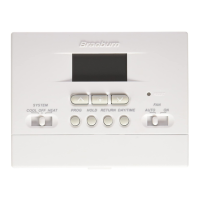
Do you have a question about the Braeburn 2000NC and is the answer not in the manual?
| Type | Non-Programmable Thermostat |
|---|---|
| Stages | 1 Heat / 1 Cool |
| Programmability | Non-Programmable |
| Backlight | No |
| Temperature Swing | Adjustable |
| Mounting | Wall Mount |
| Power Source | 24VAC |
| Display | LCD |
| Temperature Range | 45°F to 90°F (7°C to 32°C) |
| Compatibility | Single Stage Heat/Cool Systems |
Details the electrical specifications for the thermostat, including voltage and amp loads.
Specifies the operating temperature range and accuracy of the thermostat.
Outlines the battery requirements and system compatibility of the thermostat.
Lists the terminal designations available on the thermostat for wiring connections.
Provides step-by-step instructions for removing an old thermostat and preparing for installation.
Guides the user through the physical installation process of the new thermostat.
Essential safety guidelines to follow before, during, and after thermostat installation and operation.
Critical safety warnings to observe before testing the thermostat installation.
Step-by-step instructions to verify the correct operation of the heating, cooling, and fan systems.
Lists the default settings for various thermostat functions after a reset.
Instructions on how to accurately set the current time and day for program execution.
Explains how to adjust the temperature difference that triggers heating or cooling cycles.
Details how to set a temporary or permanent hold for the current setpoint temperature.
Instructions for configuring the filter replacement reminder feature.
Provides guidance and default program settings for energy efficiency.
Explains the structure of weekday and weekend programming groups.
How to view the current setpoint temperature on the thermostat.
How to temporarily change the setpoint temperature without altering the program.
How to engage a permanent or timed hold on the current setpoint.
Explanation of the automatic delay feature to protect the compressor.
How the thermostat indicates low batteries and how to replace them.
Explains the feature that gradually reaches setpoints for comfort and efficiency.
Details the feature that reminds users to replace or clean the air filter.
Solutions for when the thermostat fails to activate the heating or cooling system.
Addresses issues where the thermostat activates the wrong system mode.
Helps diagnose why the thermostat isn't adhering to programmed schedules.
Solutions for frequent or infrequent system cycling.
Explains what to do when the low battery indicator appears on the display.
Troubleshooting steps when the thermostat shows 'OFF' and the system won't start.
Solutions for a blank thermostat display, often related to battery issues.
Explains the meaning of the 'HI' display and how to resolve it.
Explains the meaning of the 'LO' display and how to resolve it.
Information regarding the upper limit for programming setpoint temperatures.
Information regarding the lower limit for programming setpoint temperatures.
Troubleshooting steps when the system fan runs constantly.
Addresses situations where the room temperature is not as expected.
Explains why the system might turn on prematurely.
Illustrates wiring configurations for 2-wire millivolt and 24V AC heating systems.
Shows wiring for 4-wire single transformer heating and cooling systems.
Depicts wiring for 5-wire two transformer heating and cooling systems.
Provides wiring diagrams specific to single stage heat pump installations.
